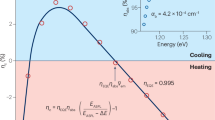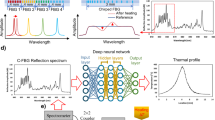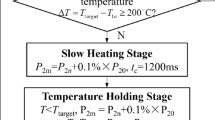Abstract
THE measurement of the melting point of a material requires determination of temperature within allowable limits of accuracy at precisely the moment when the change of state occurs. At intermediate to high temperature, a disappearing filament optical pyrometer is the most convenient temperature measuring instrument. A method which has been used extensively is the direct observation of a test fragment within a black-body furnace in which the temperature can be increased gradually until visual evidence of melting is obtained, that is, the sudden rounding of a jagged edge or pinnacle. A severe drawback in this procedure is the fact that the test sample is difficult to discern since its temperature is essentially the same as that of its environment. Furthermore, it is difficult to melt the refractory metals in a black-body furnace.
This is a preview of subscription content, access via your institution
Access options
Similar content being viewed by others
References
Angell, M. F., Phys. Rev., 33, 421 (1911).
Worthing, A. G., Phys. Rev., 25, 846 (1925).
Allen, R. D., Glasier, jun., L. F., and Jordan, P. L., J. App. Phys., 31, 1382 (1960).
Worthing, A. G., Phys. Rev., 10, 377 (1917).
Author information
Authors and Affiliations
Rights and permissions
About this article
Cite this article
ALLEN, R. Techniques for Melting-Point Determination on an Electrically Heated Refractory Metal. Nature 193, 769–770 (1962). https://doi.org/10.1038/193769a0
Issue date:
DOI: https://doi.org/10.1038/193769a0



